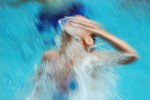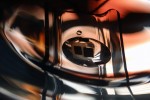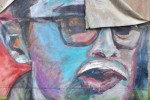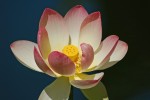Winter 2013: Prose
Whale
Non-fiction by Lyssa Tall Anolik
“I will not eat whale,” I said to my husband. We were flying from Stavanger to Bergen, Norway, a thirty-minute hop. I had just read a passage in my Lonely Planet Guide warning the traveler to expect to see “hval” on every northern Norway menu – especially in the Lofoten Islands, an archipelago 130-miles north of the Arctic Circle – which was where we were headed.
He nodded. “I understand.” While Dan, like me, does not support the practice of whaling, he is less squeamish and sits in the “I'll try anything once” camp.
He also does not share my long romance with whales and dolphins, which started in my teens. In high school, my peers hung posters of Van Halen and David Bowie on their bedroom walls. On weekends they went to parties, drank beer, and smoked pot. I pinned posters of Jacques Cousteau and “Marine Mammals of the World” to my walls. I stayed home and listened to John Denver's “Calypso,” read marine mammal field guides, and wrote letters about the misunderstood beauty and intelligence of cetaceans to the Cousteau Society's lead dolphin biologist, who occasionally sent sympathetic answers.
This inclination stemmed from my first wild whale sighting, the summer I was fifteen, in Washington State's Hood Canal. I was sitting on a rock outcropping a few feet above the water's surface, staring into the clear depths. A giant gray body, followed by equally enormous tail flukes, slid by a few feet below me. I was so stunned I lost my balance and nearly toppled into the water. “Really Big Fish,” flashed through my mind. The creature continued another fifty feet, blew a spume of white spray, then dove.
Its mottled flukes stretched out of the water and flipped down as if to wave goodbye. “Whale,” my brain finally managed.
It was, I later learned, a California gray whale. There was something different about being in its presence than I'd experienced around other wild animals. Its sentient awareness made my arms and legs tingle as it passed. My heart beat maniacally. My throat and chest ached when the animal sounded, heading off into deep waters where I could not follow.
Afterwards, I read all I could about whales – their biology, methods of communication, and highly developed social relationships. I joined Greenpeace and wanted to become a whale researcher. In the end, I didn't pursue marine biology, but I did become an environmental educator, sharing my wonder for the natural world with others.
I was shocked to learn, after arriving in Norway, that this progressive country still practices commercial whaling. The industry, while not a large economic force, is a centuries-old tradition among northern Norwegians, currently confined to a handful of small, family-run operations. They hunt the non-endangered minke whale using an explosive grenade harpoon, which they claim to be the most “humane” method currently available. Anti-whaling groups, however, do not regard this method as humane, because it's impossible to guarantee an instantaneous kill. Heated controversy over this practice rages outside of Norway, but Northern Norwegians defend their actions as an important cultural practice. They believe they are sustainably harvesting an available natural resource. They disdain their opponents as overly sentimental city folk who attribute human characteristics, such as high intelligence and emotions, to wild animals.
A week after I read the Lonely Planet Guide passage, Dan and I joined a seabird safari off the Arctic island of Vaeroy. We cruised through glassy waters, yellowed from the evening sun, in a small speedboat. We spotted sea eagles coasting over cliffs, islets full of cormorants, screaming colonies of kittiwakes nesting in cave wall crevices, rafts of floating razor bills, and the highlight: hundreds of Atlantic puffins – parrot-like birds with orange beaks, orange feet, and stubby black wings. They floated in groups, flew in swarms, dove for herring, and stood sentry-like beside their burrowed nests on hummocky hillsides.
It was a perfect excursion. The only thing that could've made it even better would be to see a whale. So as our craft turned towards town, I closed my eyes and tuned in. I said a silent prayer of thanks to the land, sea, and bird spirits of this place, then asked whatever whales may be present in the area to please grace us with an appearance. This practice of politely calling natural beings has worked for me in the past – most notably in the Peruvian Amazon where Dan and I saw two young jaguars, a rare occurrence, after we'd already seen capybaras (100-pound guinea pigs), a dozen giant otters, and an anteater-like tapir. Our guide at the time was amazed. In the case of whale-whispering, however, my method failed – or so I thought.
At the end of the evening, giddy from prolonged puffin exposure, we returned to the Gamle Prestegard, our quaint guest house on the remote north side of the island. The inn was a converted vicarage, painted red with yellow trim, beside an onion-domed wooden church.
Famished, we immediately sat down to dinner. We were served by Hege, the proprietress and chef. She asked us what we'd like to drink. Dan asked what we'd be eating. Being a small establishment, Hege prepared only one entree each evening. She smiled sheepishly and said, “Something from the sea.”
“So white wine?” Dan asked.
“Mmm...perhaps red.” Red? Why red, I wondered. Red wine goes with red meat, not fish ... Oh, crap! My stomach got a hollow, burning feeling. I knew what Hege was serving for dinner.
“Ok,” Dan said, “red it is.”
“Excellent!” Hege proclaimed and disappeared to fetch the wine. Dan and I exchanged alarmed glances.
“What do we do?” I whispered.
“I think we just have to eat it,” he said.
Hege returned with the wine, then platters of steamed vegetables and boiled potatoes with dill, followed by a farmhand-sized tureen full of a rich-smelling steaming stew, with what looked like chunks of beef floating in it.
“This,” Hege pronounced with a flourish, “is hval.” Then she explained how whaling is very much a part of this island's culture, that this stew was her grandmother's recipe, which she grew up eating, and now loves to share with her guests. “I hope you will enjoy it!” She walked purposely out of the dining room.
Our stomachs were rumbling. The dish smelled tantalizing with onions, garlic, and carrots. Dan filled his plate, ladling stew over potatoes and steamed vegetables. “Well, it's already dead,” he said, and began eating.
In the end, hunger and the desire not to insult our hostess won out over my churning conscience. I loaded my plate. I said a silent prayer to the spirit of the deceased whale, thanking it for giving its life to nourish me – and a hundred other people – and asking that its spirit be elevated to a higher place of light and love. I hoped this was enough. I speared a chunk of meat on my fork and tasted a first tentative bite. Hege did a superb job. The meat was tender and flavorful, like lean beef, stewed to the point of melting in my mouth. I ate until I thought I might be as big as a whale. I felt guilty for enjoying it as much as I did.
That night I feared I would have nightmares, but I didn't. I slept more soundly than I had in weeks.
On the ferry back to the mainland, I read Barry Lopez’s Arctic Dreams, essays about the natural history of the Arctic region, including the native people who have subsisted there for centuries on local wildlife – caribou, seals, polar bears, and whales. Lopez hunted with a band of Inuit. He described the conflicts he felt killing and eating the meat of creatures he knew to be intelligent, but in the end, he, too, did not wish to offend his hosts. He respected the difficult lives they led, as well as their reverence and gratitude for the animals who died to feed and clothe them. Historically, members of indigenous tribes believed they imbued themselves with the attributes of animals by eating their flesh and donning their skins. Modern “civilized” societies no longer experience the natural world in animistic terms, but my imagination hooked into the idea of a fluid boundary between the human and wild animal. I began to wonder what elements of whale I might have digested, beyond protein and nutrients.
Three days later, I left Norway, flying home to Seattle to visit my ailing grandfather. It turned out to be the last time I would see him alive. On the plane, I shuffled my Medicine Card deck – like a Tarot deck, but with animals instead of symbols – and randomly picked a card to see which wild spirit would guide me home.
I drew the Whale card.
I stared at the watery blue and gray image and wondered again: What exactly have I consumed?
Whales are known for the haunting “songs” they sing and pass on to successive generations. The Medicine Cards book calls Whale the “Record Keeper,” the one who holds the family history in trust. My spine tingled. My whale-whispering, it turned out, had worked better than I'd imagined. This creature I have long revered did answer my call, calling me home to witness, to hold my grandfather's hand and listen to his stories as he approached the end of his 97-year life. Whale literally appeared on my plate to nourish and sustain me for this deep task that lay ahead.
| |

|

|
 |
 |
 |
 |
 |
||||
|
Enjoy the richness: thirteen poets, nineteen poems, and a diversity of style and craft. |
Three memoirists share their emotional truths in these slices-of-life. |
Our featured artist, as well as painters and photographers, provide colorful visions that will leave you seeing the world in new ways. |
Three emerging writers share talent and creativity far beyond their years. |
Learn more about the contributors who make us proud of our Winter 2013 edition. |

